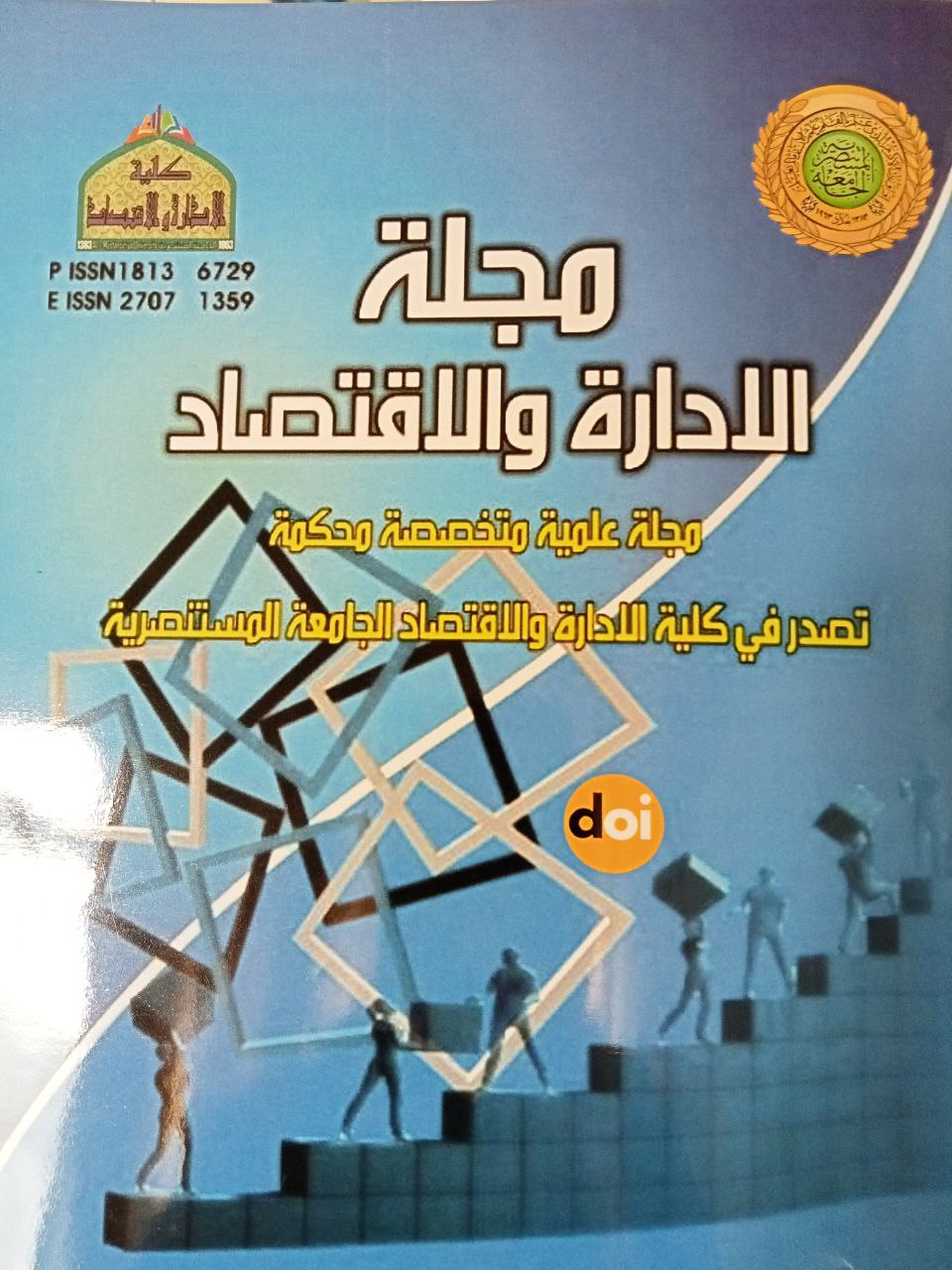Solve a linear –quadratic bi-level programming problem by applying the genetic algorithm
DOI:
https://doi.org/10.31272/jae.i127.107Keywords:
the(linear-quadratic) bi-level programming, Genetic algorithmAbstract
The Linear-quadratic bi-level programming problem it is considered a collection of researchers it is an overlapping optimization problem with two levels , one is called the upper level (independent) and the other is called the lower level (dependent),each level has objective function and constraint . It is considered a scientific and practical tool helps the decision maker to reach the optimal. To obtain efficient upper bounds and lower bounds we use the (karush-kuhn-Tucker) (KKT) conditions for transforming the "BLPP" into single level problem.
The main objective of the study is Highlighting one of the methods of solving the bi-level programming problem(BLPP) it is the Genetic algorithm (GA) that is one of the research methods used to simulate what nature does in the reproduction of living things and use it to solve complex problems to reach optimal solution or the closest possible solution to the ideal solution.
After implementing the genetic algorithm and taking advantage of its properties and the content of its steps with linear-quadratic bi level programming problem,the results showed in the case of the genetic algorithm with bi-level programming (linear-quadratic)that it gave the best possible solutions and was also able to achieve optimization by increasing the value of the objective function of type (max) the largest possible results of bi-level programming in the cases of production and demand in addition to generating them for possible alternative solutions that help the decision maker to choose what is better and closer to the state of the plant and its production reality.
References
1-Bard, J. F., Plummer, J., & Sourie, J. C (2000)." A bilevel programming approach to determining tax credits for biofuel production". European Journal of Operational Research, 120(1), 30-46.
2-Colson, B., Marcotte, P., & Savard, G. (2007). "An overview of bilevel optimization". Annuls of operations research, 153(1), 235-256. DOI: https://doi.org/10.1007/s10479-007-0176-2
3- Dempe, S., & Zemkoho, A. B. (2012). "On the Karush–Kuhn–Tucker reformulation of the bilevel optimization problem". Nonlinear Analysis: Theory, Methods & Applications, 75(3), 1202-1218. DOI: https://doi.org/10.1016/j.na.2011.05.097
4-Dempe, S., Mordukhovich, B. S., & Zemkoho, A. B. (2014). "Necessary optimality conditions in pessimistic bilevel programming". Optimization, 63(4), 505-533 DOI: https://doi.org/10.1080/02331934.2012.696641
5-Edmunds, T. A., & Bard, J. F. (1991)." Algorithms for nonlinear bilevel mathematical programs". IEEE transactions on Systems, Man, and Cybernetics, 21(1), 83-89. DOI: https://doi.org/10.1109/21.101139
6-Eghbal Hosseini,Isa Nakhai kamalabadi (2013) "(a genetic approach for solving bi-level programming problems)" AMO-Advanced modeling and optimization,volume15, Number 3, 2013.
7-Frederick S.Hiller ,Gerald j.Lieberman "(introduction to operations research )" ninth edition(2010).published by McGraw-Hill cobyright 2010.
8-Fricke, C. (2003). "An Introduction to Bilevel Programming". Departement of Mathematics and Statistics, University of Melbourne.
9-G.Z.wang ,wan,x.wang,y.lv, "Genetic algorithm based on simplex method for solving linear-quadratic bi-level programming problem", computers and mathematics with applications , 2550-2555, 2008
10-Ghadimi, S., & Wang, M. (2018). "Approximation Methods for Bilevel Programming".Cornell university. arXiv:1802.0224 vl[math.oc] 6 Feb 2018.
11- H.I.Calvete,c. cale, "Apenalty method for solving bi-level linear-fractional linear programming problems", Asia-pacific journal of operational research 207-224, 2004.
12-Hamdy Taha ,"Operations Research: An Introduction (8thEdition)"and(9th Edition). Published by Prentice Hall (2007)
13-Hansen, P., Jaumard, B., & Sa-vard, G. (1992)." New branch-and-bound rules for linear bilevel programming". SIAM Journal on scientific and Statistical Computing, 13(5), 1194-1217. DOI: https://doi.org/10.1137/0913069
14-Hosseini, E., & Kamalabadi, I. N. (2015). "Two approach to solve nonlinear bilevelfor solving non-linear bi-level programming problem". Advances in Computer Science: an International Journal.
15- Lv, Y., Hu, T., Wang, G., & Wan, Z. (2008). "A neural network approach for solving nonlinear bilevel programming problem". Computers & Mathematics with Applications, 55(12), 2823-2829. DOI: https://doi.org/10.1016/j.camwa.2007.09.010
16-Ma, S. (2016)." A nonlinear bi-level programming approach for product portfolio management". SpringerPlus, 5(1), 727. DOI: https://doi.org/10.1186/s40064-016-2421-0
17-Marcotte, P. (1986). "Network design problem with congestion effects: A case of bilevel programming". Mathematical programming, 34(2), 142-162. DOI: https://doi.org/10.1007/BF01580580
18-Marcotte, P., Savard, G., & Zhu, D. L. (2001). "A trust region algorithm for nonlinear bilevel programming". Operations research letters, 29(4), 171-179. DOI: https://doi.org/10.1016/S0167-6377(01)00092-X
19-Migdalas, A. (1995). "Bilevel programming in traffic planning: Models, methods and challenge". Journal of global optimization, 7(4), 381-405. DOI: https://doi.org/10.1007/BF01099649
20-Moore, J. T., & Bard, J. F. (1990)." The mixed integer linear bilevel programming problem". Operations research, 38(5), 911-921. DOI: https://doi.org/10.1287/opre.38.5.911
21-Pal, B. B., & Moitra, B. N. (2003)." A fuzzy goal programming procedure for solving quadratic bilevel programming problems". International Journal of Intelligent Systems, 18(5), 529-540. DOI: https://doi.org/10.1002/int.10102
22-Sahin, K. H., & Ciric, A. R. (1998)." A dual temperature simulated annealing approach for solving bilevel programming problems". Computers & chemical engineering, 23(1), 11-25. DOI: https://doi.org/10.1016/S0098-1354(98)00267-1
23-Savard, G., & Gauvin, J. (1994). "The steepest descent direction for the nonlinear bilevel programming problem". Operations Research Letters, 15(5), 265-272. DOI: https://doi.org/10.1016/0167-6377(94)90086-8
24-Sinha, A., Malo, P., & Deb, K. (2017)." A review on bilevel optimization: From classical to evolutionary approaches and applications". IEEE Transactions on Evolutionary Computation, 22(2), 276-295. DOI: https://doi.org/10.1109/TEVC.2017.2712906

Downloads
Published
Issue
Section
Categories
License
Copyright (c) 2022 Journal of Administration and Economics

This work is licensed under a Creative Commons Attribution 4.0 International License.
The journal of Administration & Economics is an open- access journal that all contents are free of charge. Articles of this journal are licensed under the terms of the Creative Commons Attribution International Public License CC-BY 4.0 (https://creativecommons.org/licenses/by/4.0/legalcode) that licensees are unrestrictly allowedto search, download, share, distribute, print, or link to the full text of the articles, crawl them for indexing and reproduce any medium of the articles provided that they give the author(s) proper credits (citation). The journal allows the author(s) to retain the copyright of their published article.
Creative Commons-Attribution (BY)









